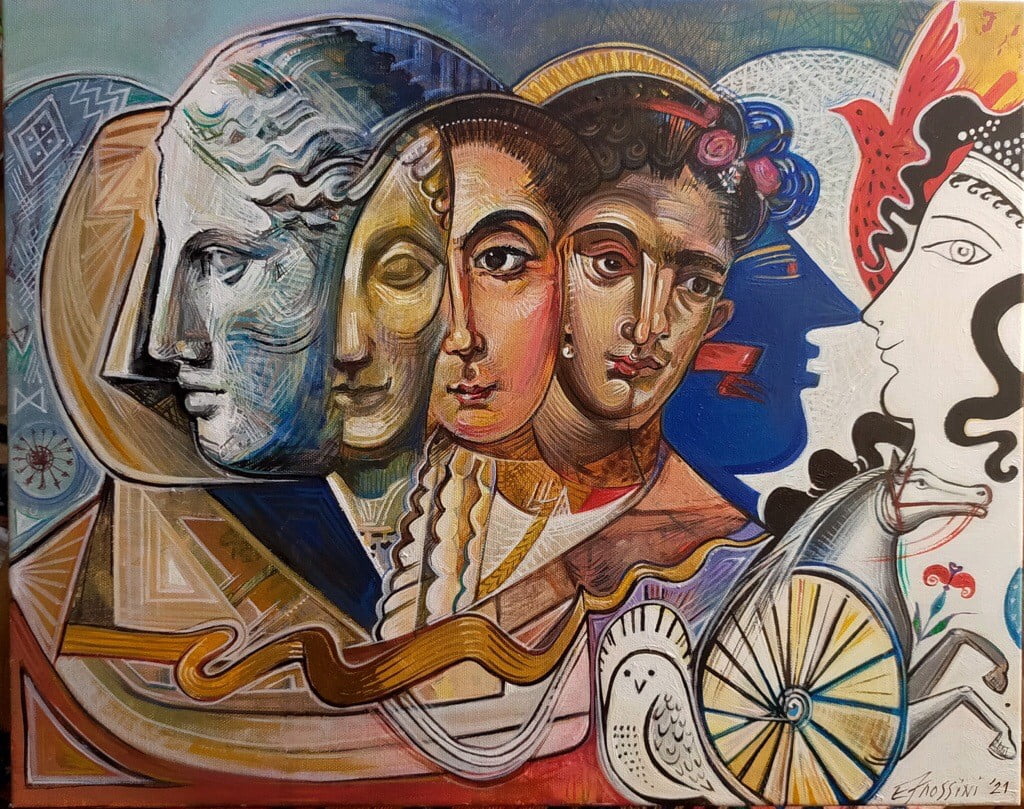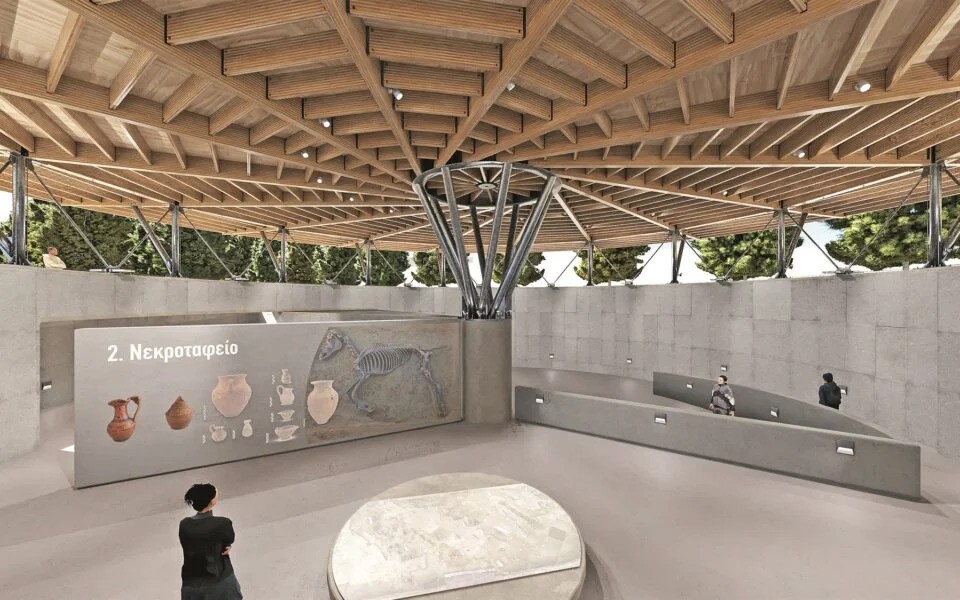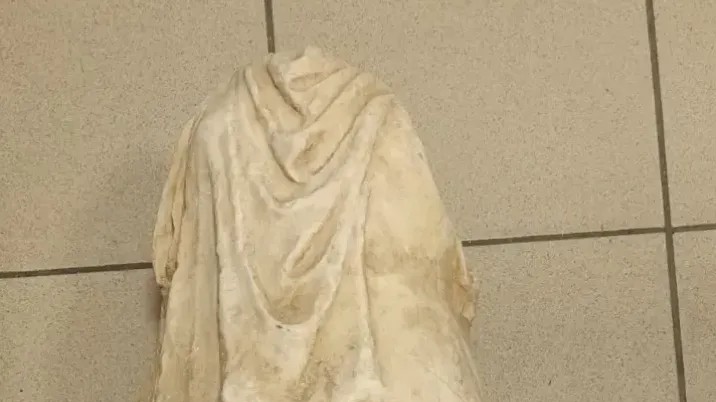Metamorφosis with a phi, Greek Australian artistry in flux on the streets of Mebourne


Metamorphosis is a biological process by which an animal physically develops after birth or hatching, involving a conspicuous and relatively abrupt change in the animal’s body structure through cell growth and differentiation.
One starts off in one form and then transforms into another. That transformation however, is inevitable. It is written in the life-form’s destiny.
In the case of Jesus, metamorphosis takes the form more of a revelation. Christ on Mount Tabor becomes radiant in glory and his disciples also take part in that metamorphosis, as it enables, as the Apostle Paul states in his letter to the Corinthians, the “transformation of believers” via “beholding as in a mirror the glory of the Lord.”
It is therefore fascinating that this year’s Antipodean Palette Exhibition, held by the Greek Australian Cultural League, a fixture on our community’s calendar, at Duckboard Place, Melbourne between 17-30 May, has chosen to link the word Metamorphosis or rather Metamorφosis, with all its polyvalences, with the Greek Revolution of 1821.
Immediately within the title, we sense an ambiguity, a paradigm shift that sits uneasily with conventional interpretations and portrayals of the birth pangs of our modern incarnation. Take the letter Φ, for instance, which dominates the title of the exhibition. While remaining the same in outward form throughout the ages, it too has undergone a process of metamorphosis at least in so far as pronunciation goes. While in Archaic and Classical times, it represented an aspirated voiceless bilabial plosive, by late Antiquity, its pronunciation shifted to that of a voiceless bilabial fricative and by the Byzantine period it developed its modern pronunciation as a voiceless labiodental fricative. Are the artists participating in the exhibition thus trying to tell us that within uniformity of signifier, there are multitude of things signified? That while the outward forms of Hellenism, of Nation and of Re-genesis may be universally employed, they mean different things to different people?
If so the use of Phi to replace ῾f῾ in the exhibition’s title is inspired, because of its equivocal nature. It can signify the golden ration achieved when two quantities’ ratio is the same as the ratio of their sum to the larger of the two quantities, or the magnetic flux through a surface, expressed as the surface integral of the normal component of the magnetic field over that surface, or indeed in visual perception as the phenomenon of apparent motion that is observed if two nearby optical stimuli are presented in alternation with a relatively high frequency.
It is worth viewing the artworks submitted to the exhibition which such frequency, especially given their novel role this year, as street art and to ponder their magnetic flux in relation both to the Greek Revolution and to the Metamorphosis, a series of collage-drawings by Joan Miró, made between 1935 and 1936, expressing his unease at the unstable political situation in Spain on the eve of the Spanish Civil War.
No Civil War threatens Greece and though we may be celebrating the bicentenary of the 1821 revolution, the artworks comprising the exhibition generally lack the exuberance and the triumphalism one would expect from a commemoration of such an important national event. Instead, the compositions are subdued, uneasy and introspective.


The metamorphic process
For Efrossini Chaniotis, the metamorphic process is as natural and inevitable as that of the natural world, and in her piece, “One-Eye,” continuity, despite change is emphasised. As the artist states: “From the earliest expressions of the human figure, Greek artists have ‘passed the baton’ onto the next generation of artists.” Thus, her canvas is populated by human representations from the Minoan, Cycladic, Archaic, Classical, Hellenistic and Byzantine Periods, the Byzantine figure appearing as if he is occupying a liminal space between the Cretan school and Yiannis Tsarouhis. While the artist opines that “Metamorphosis… is not lineal…if we do not look back, marvel ponder and learn from the ones who started the race we are poorer for it, I think,” her figures look in all directions, not just backwards, while two appear to be blind. For the artist, then, diversity of perspective is everything and while most of the figures seem to attempt to drag the central figure into the past, that Kontoglou-like figure has its gaze fixated upon a horse-like figure that is in the process of metamorphosing into a chariot or vice versa, compelling the viewer by its dynamism to transcend the edge of the composition and move beyond it.
All in all “One Eye” is an arresting work that while summarising the breadth of our aesthetic experience, refuses to be shackled by it. This is significant if one considers that the word revolution literally means a circular motion, where things revolve to where they should be, whereas the modern Greek word for it, επανάσταση signifies standing upon one’s two feet again, and again, whereas the ancient word for the same process, was νεωτερισμός, (being modern). The shadowy blue, Fassianos like figure on the other hand, looks solely at a Minoan precedent, as if in mirror image, leaving us to speculate as to its real existence.
Virginia Polendakis’ thought provoking representation of ελευθερία (freedom) as a type of sphinx further reinforces the enigmatic way in which we are called upon to negotiate our identity and interpret the meaning of the 1821 Revolution. Like us, the sphinx is a syncretic being, a polymorphous conglomeration of powers and attributes harnessed in different times and at disparate places. To seek to reduce a phenomenon that defies description to stock phrases or sterile stereotypes is to disrespect the perplexity of her existence and to invite tragedy and annihilation, most probably by asphyxiation, whence the name of the sphinx derives.
In poet and artist George Athanasiou’s striking and inspired composition “Uncreated Insight,” the ambiguity of the image is contained in the very title itself. The metamorphosis at play here is not just in the image, which, depending upon which way you look upon it, can assume the guise of fire-ravaged columns, oppressive sky-scrapers or menacing totalitarian monoliths emerging against a fiery sky, but in its interpretation. The suggestion here is that while the works of mankind are made manifest by their act of creation, the means to quantify and evaluate their significance exist beyond the confines of this world. Modelled on a stylised depiction of the artist’s hand, the piece has a world-weary feel, as if a primordial devastated being is variously slowly emerging from, or reluctantly sinking into the ground. Either way, rather than being triumphalist, we would do well to heed the artists warning and prudently seek uncreated insight before we draw to conclusions about our own metamorphosis and progression. There is unfinished business here.
Whereas in the poetry of Donald Davidson the Dryads illustrate the themes of tradition and the importance of the past to the present, Tina Sideris employs the motif of this ancient Greek mythological woodland creature in her artwork to emphasise a natural world that is not only constantly in a state of flux but which also forms the vessel within all paradigms of identity national or otherwise, must necessarily be explored. An understanding of country, of tradition and of history must inevitably refer to place and in seeking to understand ourselves and to purport to assess our achievements or measure the extent of our manifold metamorphoses outside of our natural environment is a pursuit that leads to delusion. In ancient myth, the lives of the Hamadryads were inextricably linked to their trees. Little thought has traditionally been given to the natural environment during 1821 and it is time that this gaping lacuna in the national narrative, as well as the void between that narrative and the Greek people’s historical relationship to their surrounds is filled and granted greater primacy.
Given the multiplicity of perspective displayed by the many artists taking part in the exhibition, perhaps it is fitting to end with one of the most dramatic, Thalia Andrew’s Change – a symbol of Life. A butterfly, having emerged from its chrysalis is taking its first flight. The artist describes the metamorphosis of the animal into a butterfly as its “true life-purpose.” The scene is ethereal and emotive yet also disconcertingly enigmatic. Is it dawn, the symbol of hope and new life, or is the sun actually setting, about to plunge everything into darkness. If we are to parallel the emergence of the metamorphosed lepidopterous with the awakening of Modern Greece, in Thalia Andrew’s poetically charged vision, we find ourselves in a quandary as to whether we should celebrate the emergence of new life, or again identifying it with that of the butterfly, lament the fact that it is so precarious and ephemeral. The trajectory of the butterfly is exuberant.. too much so in fact. Is this then a cursory tale about our Icarian tendencies as a people? What shall be revealed when the sun reaches its zenith. It is this exploration of potentialities, both light and dark that makes this piece, a true masterpiece.
Few community events have, having the 1821 Revolution as their inspiration, engaged so deeply, so dextrously and so sincerely with an analysis of our own metamorphosis, how that relates to our sense of freedom and what ramifications that has for our collective ontology. It is for this reason that the participating artists and the Greek Australian Cultural League’s contribution to the introspective process of evaluating our progress as individuals and as a people thus far has such profound and far-reaching implications for all of us.
Written by Konstantinos Kalymnios. The article was kindly provided to us by the author to be published in the Vema.




